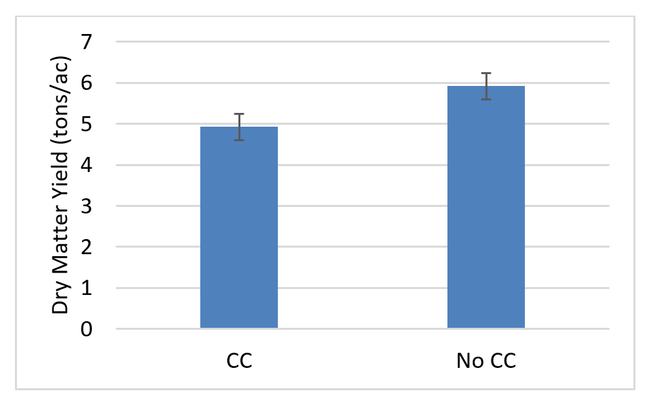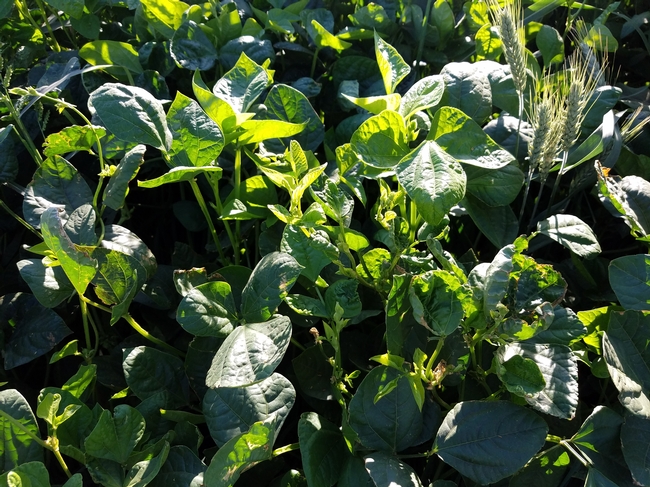In 2020, we completed a three-year on-farm trial in the Delta to evaluate warm-season legume cover cropping between winter small grain forage crops. Cover cropping is a management practice identified in the Healthy Soils Program of the California Department of Food and Agriculture as having the potential to improve soil health, sequester carbon, and reduce greenhouse gas emissions. Our objectives were to evaluate summer cover cropping for its potential to improve soil tilth at a time of year when the soil would usually be fallowed and dry with no soil cover, and to better understand the agronomic practices that might make summer cover cropping more feasible for Delta farmers. This article summarizes select results from the trial. A detailed report is available on the Delta Crops website.
The trial took place over 4.5 acres of a commercial field, and we compared a cowpea (cultivar ‘Red Ripper') cover crop treatment (CC) to fallow soil (No CC). The cultural practices varied across years (Table 1). Irrigation was only applied to the cover crop plots. In 2020, we estimated that five inches of irrigation was applied to the cover crop, using surface water with moderately low salinity (seasonal ECw of 0.5 dS/m).
Table 1. Agronomic practices during the three-year study.
We soil sampled twice per year. The first sampling occurred following triticale harvest but prior to tillage and cover crop planting. The second occurred at the end of the cover crop season immediately prior to cover crop termination. Soil was sampled from 0-6, 6-12, 12-24, and 24-36 inch depths. We evaluated bulk density, salinity (electrical conductivity, ECe), pH, total nitrogen (N), and total carbon (C). Additionally, in-situ water infiltration was measured at the conclusion of the project (i.e. prior to 2020 cover crop termination). We hand-harvested cover crop biomass, separated it into cultivated cowpeas, volunteer small grains, and weeds and analyzed each component for total C and N. We hand-harvested triticale forage in 2019 and 2020.
Soil properties. After three years of cover cropping, we did not observe improvements in total N or bulk density from cover cropping, and our statistical analysis indicated that total C was impacted by plot location. This suggests that an inherent soil characteristic, like texture, was having more of an impact on total C than the cover crop treatment. We observed better water infiltration in the CC plots (Figure 1). Cover crop roots likely contributed to better soil structure and water conductance. We also observed lower salinity and higher (i.e. less acidic) pH in the CC plots. Root zone salinity (0-36 in) averaged 1.4 dS/m in the CC plots and 2.2 dS/m in the No CC plots. Root zone pH averaged 5.7 in the CC plots and 5.5 in the No CC plots. These results suggest that cover cropping can improve certain soil characteristics, particularly those related to soil-water status, on a relatively short time frame. Changes in nutrients and C storage, however, are less likely to be observed following short-term changes in management.
Figure 1. Three years of cover cropping improved water infiltration (P=0.0198) compared to the standard dry fallow. The error bars represent the standard errors. The photo illustrates how there were visible differences between treatments, even after triticale forage harvest and uniform tillage operations. No CC soil was a fine powder (bottom of the photo); whereas, CC soil was observed to have better aggregation. The grower observed differences in subsequently-planted small grains, with seedlings in the CC plots emerging about five days earlier than seedlings in the No CC plots.
Cover crop stand. Cover crop composition varied over the course of the study and was likely impacted by cultural practices, like planting and irrigation methods. While cowpea was the only seed planted, the stand was a mix of cowpea, volunteer wheat/triticale, and weeds. We observed that the 2020 practices and timing of operations resulted in the least amount of weed growth (Figure 2) and seed heading.
Figure 2. Proportion of cowpeas, small grains, and weeds in total cover crop biomass, and total C and N inputs from the cover crop.
Triticale forage yield. Despite certain soil health benefits, cover cropping did not improve triticale forage yield. The No CC treatment yielded higher than the CC treatment across both years (Figure 3). The CC plots yielded below the two-year field average of 5.5 tons per acre, and the No CC treatment yielded above the field average yield. Given the improved infiltration, pH, and salinity conditions in the CC treatment, the yield result is difficult to explain, but machine harvesting over a larger area might lessen the difference between treatments.
Figure 3. Triticale forage yield as tons of dry matter per acre. The No CC treatments yielded higher than the CC treatments across both years (2019-2020) (P=0.0059).
Summary. In our three-year study, cover cropping had no effect on total N, bulk density, and total C, but water infiltration, salinity, and pH were improved. Triticale forage (i.e. cash crop) yield did not improve as a result of cover cropping, however. Cowpea stand establishment and volunteer grain and weed competition were the biggest challenges to growing a summer cover crop at this site, but earlier planting and termination reduced the weed pressure. Despite these challenges, the grower observed better soil aggregation in areas of the field where the cover crop had grown. Overall, the potential benefits of cover-cropping may not be realized in the first few cover crop cycles, which could hinder long-term adoption. Results may also depend on the cover crop biomass obtained and other site-specific factors. While scientific studies have demonstrated soil health and cash crop yield improvements with cover cropping, more long-term studies are needed in California to demonstrate how these benefits can be realized.
Acknowledgments. This project was supported by the California Climate Investments program. We thank Dawit Zeleke, Morgan Johnson, and Jerred Dixon of Conservation Farms and Ranches for hosting the trial. We thank Tom Johnson of Kamprath Seed and Margaret Smither-Kopperl and Valerie Bullard of the NRCS PMC for information and advice on cover cropping.
Attached Images:




